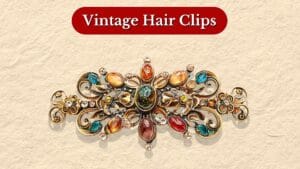Got some old hair accessories from your mother? If yes, you’re lucky because some tiny vintage pieces, like those vintage hair clips, are quite in demand today. But I’ve watched too many people overlook museum-quality hair clips because they didn’t know what they had.
But you won’t be that person! I’ve curated this guide for you to help you spot valuable vintage hair clips that could actually fetch up to $5,000 or more. From key signs of authenticity and age to factors that impact value and rare examples, this guide has it all!
Why Are Vintage Hair Clips Collectible?
Decorating hair isn’t a modern practice; it’s been there for over 30,000 years. But the distinctive hair clips we’re talking about? These came around during the Victorian era, around the 1860s.
Back then, clips were made with natural materials to help women with elaborate updos. Then each decade brought new styles, different materials, and better ways of making them. That’s why you’ll never find a genuine tortoiseshell clip in stores today, but a Cartier Art Deco piece can sell for thousands.
From unique materials to complex decoration methods, vintage hair clips were really a piece of art, unlike modern accessories. And that’s what makes these tiny pieces collectible today.
How to Identify & Date Antique Vintage Hair Clips?
Identifying authentic vintage hair clips isn’t quite difficult if you know what to look for. From design details to materials, old pieces display certain signs of authenticity and age. Here’s a breakdown of all features that matter:
Types of Clips
Different clip types came from different eras, so identifying the style will help narrow down the age.
- Barrettes: These use a spring mechanism where one piece slides under another to create the tension that holds hair. They’re shaped like bars and have decorative fronts.
- Snap Clips: Basic flat metal pieces with no hinges that simply snap open and close using spring action. You’ll find these throughout most of the 1900s.
- Hairpins: A common type that’s been around since the Victorian times, these U-shaped or straight pins look like fancy bobby pins with decorative tops.
Materials Used
The materials give you the biggest clues about age and value since vintage clips used stuff that’s either illegal or not made anymore.
Natural Materials:
- Tortoiseshell: This was the luxury choice for Victorian and Edwardian clips. You can spot genuine pieces by the spotted patterns and rough knife marks. Since it’s been illegal since 1973, real tortoiseshell clips are highly rare.
- Ivory: It was used for accessories before regulations banned it. Real ivory feels smooth and creamy with tiny cross-hatched lines visible if you look closely.
- Horn: Horn was a popular material for clips as it was easy to heat and shape into different forms. It’s lighter than tortoiseshell and can be either transparent or opaque.
- Bone and Mother-of-Pearl: These are found on higher-end pieces, often with detailed carving or used as decorative inlays.
Metals:
- Gold and Sterling Silver: The premium materials used commonly during the Art Nouveau and Art Deco periods. Look for hallmarks; “925” means sterling silver, “14K” or “585” means gold.
- Gold-Filled and Rolled Gold Plate: This is gold that’s mechanically bonded to cheaper base metal. Not solid gold, but still more valuable and durable than simple gold plating.
- Brass and Steel: Most average kinds of hair clips typically have brass or steel bodies, usually covered with silver or gold plating. You can easily spot them by their weight and aging signs.
- Pot Metal: This was common in the mid-1900s hair clips. But it tends to pit and corrode over time, so finding intact pieces can be difficult.
Early Plastics:
- Celluloid (1870s-1940s): The first plastic used for hair accessories, usually made to imitate tortoiseshell or ivory. But you can spot it by a faint camphor smell when rubbed or touched with a heated pin. Be careful, I almost ruined my piece while doing it.
- Bakelite (1920s-1950s): Especially popular in Art Deco clips, Bakelite came in brilliant colors and felt solid and heavy compared to modern plastics. You can sometimes identify it by rubbing with Simichrome polish; the cloth you’ll use will turn yellow.
- Lucite (1940s and later): This is a clear acrylic that was easy to mold and carve. Often had glitter or small objects embedded inside. Much lighter and clearer than Bakelite.
Important Markings
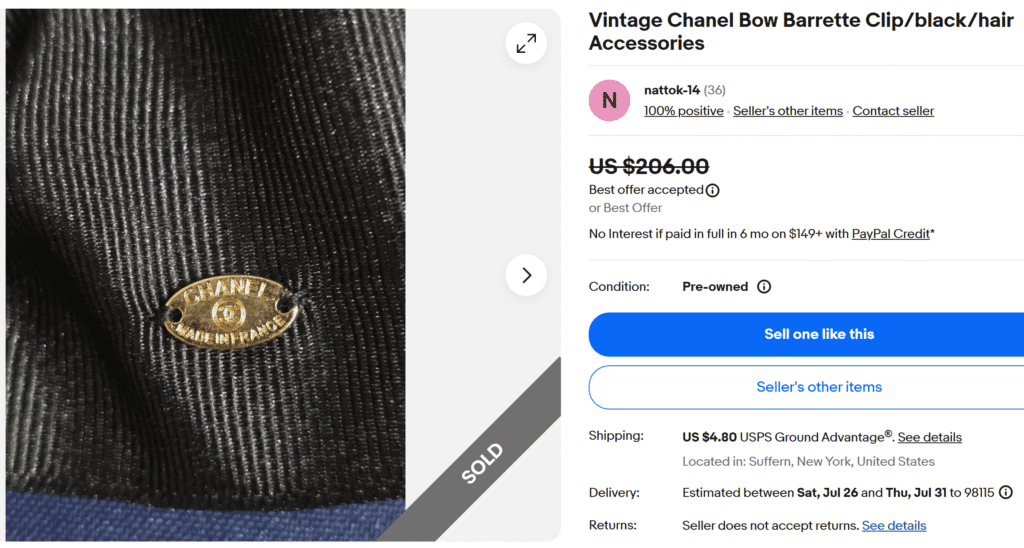
Vintage hair clips often have tiny marks that tell you who made them and when. These little clues are essential for dating and authenticating old pieces.
First are the company marks. Look for small initials, names, or symbols stamped somewhere on the clip. In some pieces, like the Chanel clip shown above, you may find metal tags.
Once you spot this marking, do a quick research about that company online to see when they were operating and narrow down your clip’s age.
Sterling silver or gold clips should have stamped hallmarks on them showing what the metal actually is and how pure it is.
Rare, but sometimes you’ll find patent numbers, especially on clips with unique clasp designs. You can search these in patent databases to find exactly when they were filed.
Design Details
Each major period had significant design impacts on hair clips. These features can help you date a vintage piece.
Victorian Hair Clips (1837-1901):
If you see elaborate decoration and expensive stuff on a clip, it’s likely a Victorian piece. You’ll generally find:
- Real tortoiseshell, ivory, gold, and silver materials
- Mourning jewelry themes with black materials
- Romantic symbols, like hearts, flowers, bows, love knots
- Detailed hand-carved and engraved work
- Dark, rich color schemes
- Sentimental sayings or secret compartments
Art Nouveau Clips (1890s-1910s):
Antique hair clips from this era seem to copy nature with design elements that flowed as if they were alive. Here’s what you’ll see:
- Asymmetrical and curvy lines
- Nature themes, such as flowers, leaves, bugs like dragonflies and butterflies
- Mythical creatures and women with flowing hair
- Intricate metalwork with fine details
- Muted colors using special enamel techniques
Art Deco Clips (1920s-1930s):
Art Deco clips have a very distinctive, sharp, and geometric look, along with the following features.
- Geometric shapes (lines, angles, chevrons, zigzags, stepped patterns)
- Perfect symmetry and high contrast
- Bold color combos
- Bakelite & white metal or plated bodies
- Rhinestone work
Mid-Century Clips (1940s-1960s):
Clip designs in this era got softer, with many patriotic themes and refined elements, along with:
- Pearls and tasteful sparkle
- Softer flower and ribbon designs
- Wartime patriotic symbols (eagles, flags, “V for Victory” signs, etc.)
- More plastic materials (Lucite and early acrylics)
- Cleaner, simpler designs
Decoration Techniques
The decoration technique tells you about the vintage clip’s age, quality, and origin.
- Hand-Painting: Found on metal, wood, or celluloid pieces. Real hand-painting shows slight irregularities, like uneven brush strokes, and color variations that machines don’t make.
- Carved Work: Materials like wood, bone, ivory, or early plastics were carefully cut away to create raised designs. Hand-carved pieces show tool marks and small asymmetries that machine work doesn’t have.
- Inlay & Enamel Work: High-end clips often had inlay work, i.e., different materials cut and fitted flush into the surface to create mosaic-like patterns. You’ll also find enameling work, like Plique-à-jour (Art Nouveau), Champlevé, and Guilloché (Edwardian and Art Deco).
- Filigree: Most Victorian and Edwardian pieces, especially sterling silver pieces, show filigree. It’s delicate openwork made from thin metal wires, twisted and curled into unique patterns.
Closure Mechanism
While it often goes unnoticed, the mechanism behind the hair clip can also offer hints about its age. As an example, early Victorian hair clips typically used simple C-clamps or basic pin mechanisms. The spring-loaded mechanisms became popular in the early 1900s.
The barrettes with hinged bars that click into grooves, which most people recognize today, didn’t become the standard until the mid-1900s.
What Makes Vintage Hair Clips Valuable?
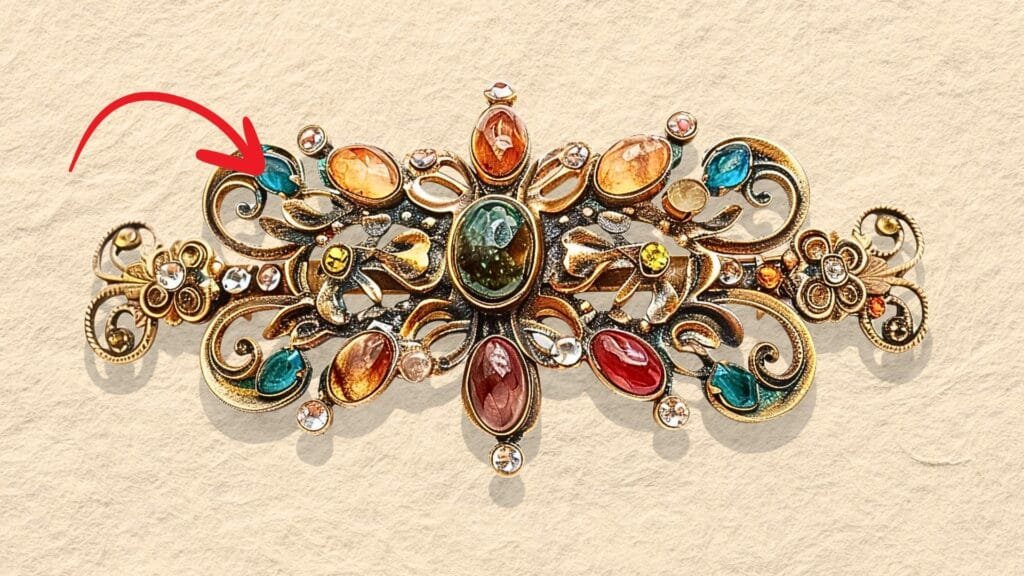
But what decides whether a vintage clip is worth $20 or $20,000? Well, there are certain factors you need to assess to find out if and how valuable a clip is.
Condition
The first and most important factor is condition, because nobody wants to pay for a broken or worn-out piece. The better the condition, the more valuable the clip.
So, assess your old hairclip’s condition correctly. Pay attention to the joints, clasps, and decoration. Poorly preserved pieces generally show the following signs and aren’t worth much:
- Major cracks
- heavy tarnish
- Lots of missing stones
- Broken clasps
- Obvious repairs
On the other hand, if you see no flaws or wear at all on the clip with all pieces intact, you’re looking at a museum-quality piece. But remember, condition alone cannot decide how much a vintage clip will be worth.
How Rare Is It?
Scarcity means higher desirability and worth. In the case of antique hair clips, here is what makes them rare:
- Limited Production: If the company only made a few pieces of a certain hair clip style, or made them for a short time, they become difficult to find over time.
- Unusual Materials: Clips made from materials that are now illegal to use or hard to work with are highly sought after. Real tortoiseshell, rare Bakelite colors (especially clear or translucent pieces), or exotic materials like jade and amber all command premium prices. Real gemstones like diamonds make them even more valuable.
- Famous Makers: Pieces by well-known jewelry companies or designers like early Trifari, Miriam Haskell, Napier, Eisenberg, Coro, or Cartier are highly collectible. That’s why markings play a vital role in valuation, too!
- Complete Sets: Many companies released matching sets —a large decorative comb with smaller clips and other accessories. Finding a complete set is rare and valuable.
- Unique Design Elements: Artistic pieces or designs related to important fashion moments can be extremely collectible.
Provenance & Documentation
A hair clip with an interesting history or celebrity connection becomes much more desirable. Details about previous ownership, like who had it, how long they kept it, and when they wore it, all add to the value.
A clip with documented celebrity ownership can sell for ten times more than an identical piece without that backstory. Designer attribution works the same way. But you need real proof, including old photographs, personal letters, original purchase receipts, auction house records, or documented sales history.
Also, original boxes, display cards, tags, instruction manuals, velvet pouches, receipts, and appraisal documents are extremely important. They can boost the clip’s worth crazily!
11 Rare Antique Vintage Hairclips Worth a Lot of Money
Below, I’ve added some real examples of rare vintage hair clips that actually sold for hundreds in sales or auctions due to their rarity and desirability!
1. M. Scognamilglio Twin Sisters Cameo Barrette
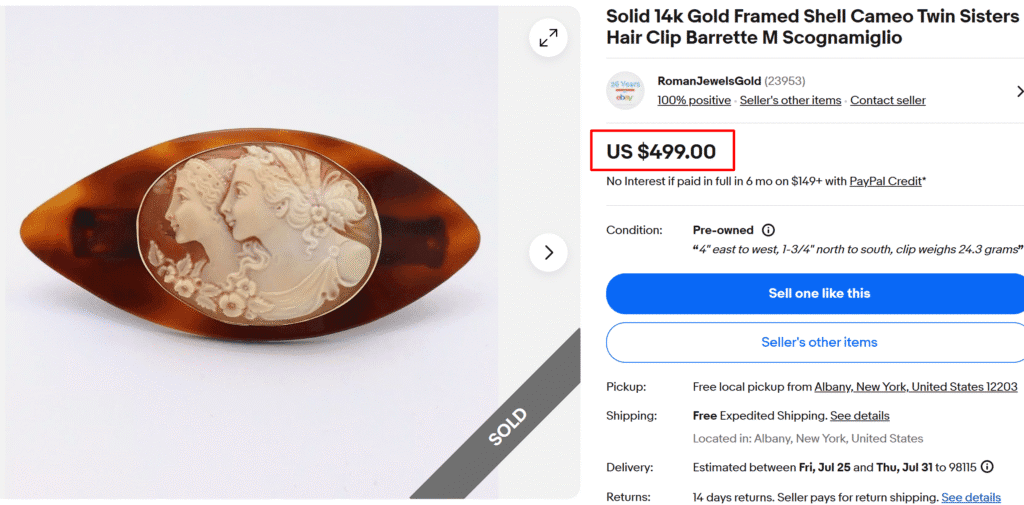
This is a super rare cameo hair clip, which is extremely difficult to find these days! It’s an M. Scognamiglio cameo barrette featuring a hand-carved tortoiseshell-colored shell showing cream-colored carved twin sisters in profile, all set in solid 14k gold.
Genuine gold cameo clips often have substantial gold weight, like this one weighs around 24.3 grams. Scognamiglio is a legendary Italian family that’s been carving cameos since 1857, and their work is highly sought after; no wonder this barrette sold for almost $500!
2. Patented Flapper Double Wave Hair Clip/Wavers
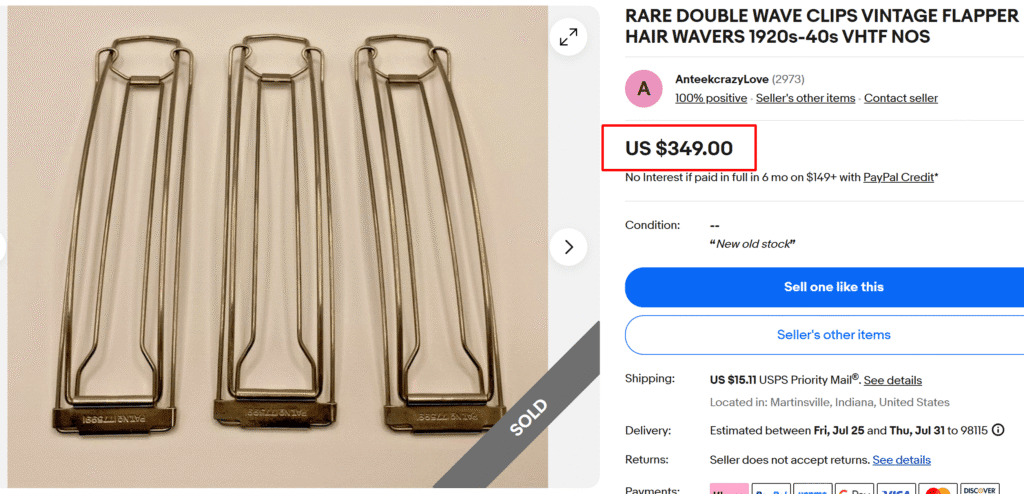
These metal double wave clips are iconic finds! Each clip is designed like the original Ehrlich Rose’s wavers, and is a patented piece by Lapin Specialty Manufacturing Co., Inc. Ehrlich patented these waver clips in 1929-1930.
These are like multi-part flat-curlers, so you’ll see sliding parts for fastening and flat clasps with a clamping bow. Authentic pieces will always have the patent numbers engraved on the metal stripe at the end.
Double-waver clips are truly iconic, so these can sell for $80-$120 per clip in excellent condition. This pair of three clips sold for almost $350, proving its rarity!
3. Chanel Paris Silk Camellia Flower Ribbon Hair Clip
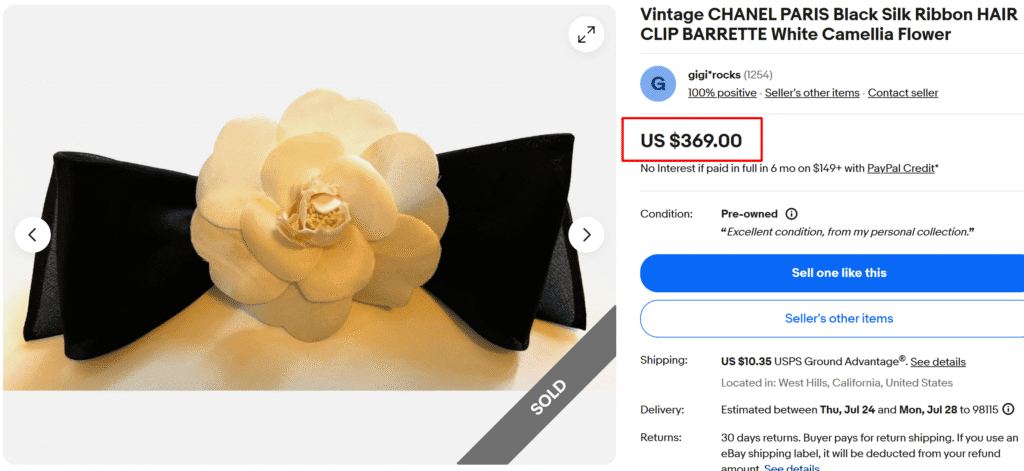
This is a stunning Chanel barrette clip featuring the brand’s most iconic motif, the white camellia flower, sitting on top of a black silk ribbon bow. The camellia was Coco Chanel’s favorite flower and became a signature element in her designs.
To authenticate this vintage hair clip, look for the “Made in France” marking on the back of the clip. You’ll also find a small metal tag reading “Chanel/Made in France” and the CC logo stitched to the back of the bow.
These iconic Chanel hair clips are quite valuable, fetching $200-$1,000 or more, depending on the condition. The original box or pouch can further boost the value.
4. Tiffany & Co. Sterling Wishbone Hair Clip
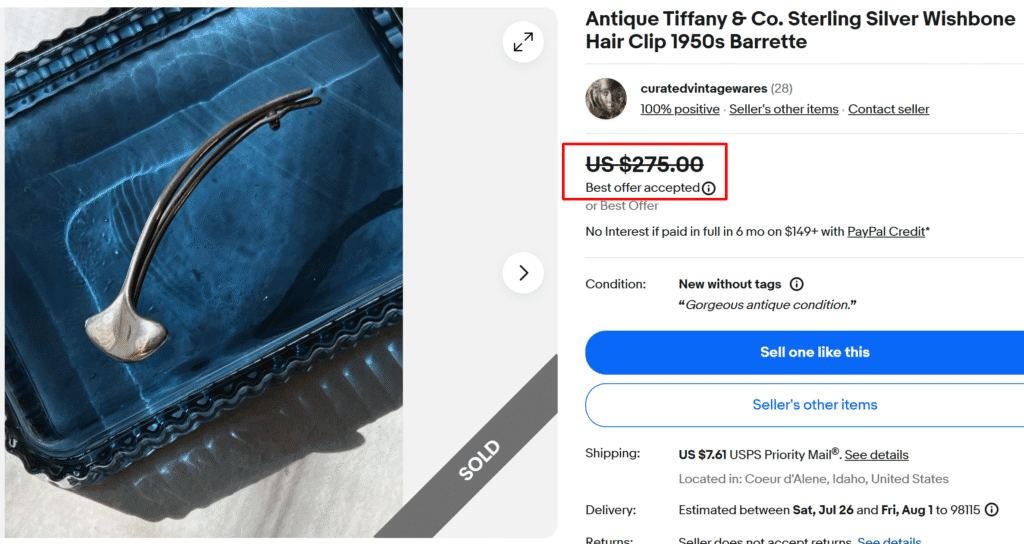
This vintage Tiffany & Co. piece from the 1950s shows the classic wishbone design that became one of the brand’s most recognizable motifs. The wishbone was a charm for good luck and a highly sought-after design motif during the post-war era.
Although a relatively simpler design, the popularity of Tiffany and its design, along with pure Sterling build, is what makes this piece worth the price tag of $275!
5. Art Deco Rhinestone & Silver Hair Clip Barrette
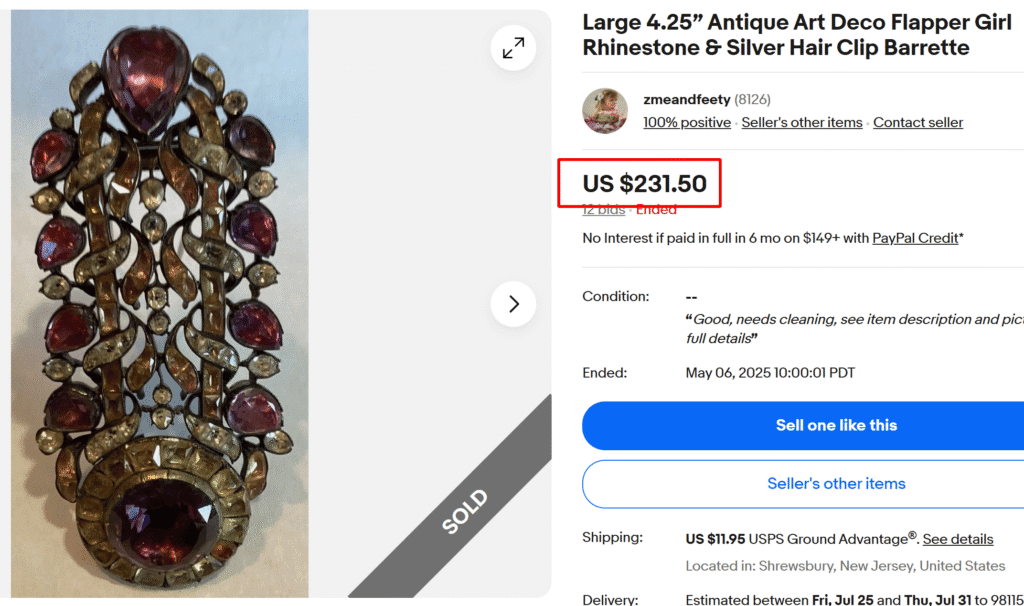
This is a gorgeous barrette featuring that classic flapper-era design with tons of rhinestones set in silver-tone settings. You can see the intricate geometric patterns and bold color combination of silver and deep red, which tells it’s a real Art Deco piece.
Antique rhinestone hair clips have high desirability. And finding one with all stones intact and in good condition is quite difficult. While this piece with unmarked silver-like metal sold for about $230, hallmarked pieces with real silver can easily fetch up to $500 or more.
6. Mizpah 14K Gold Small Barrette Clip
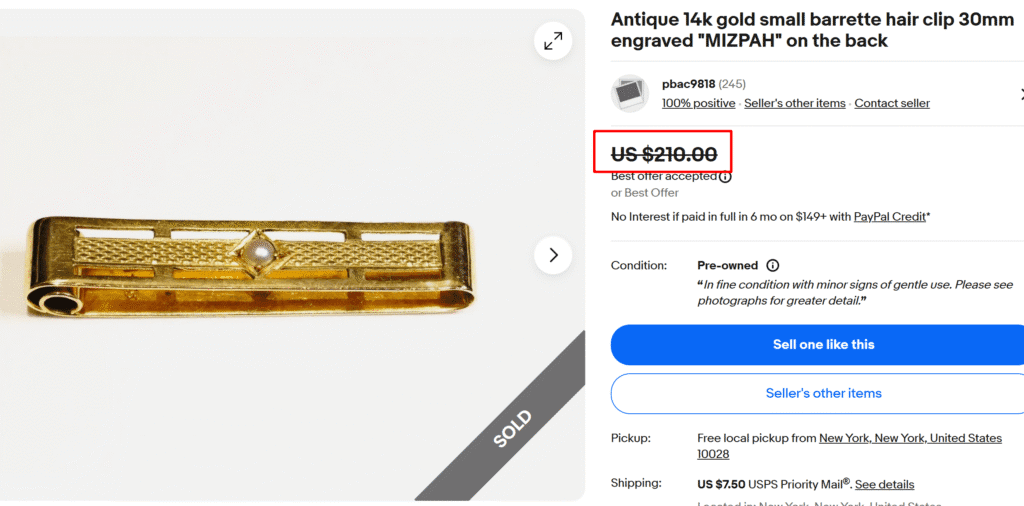
A hair clip fully made of 14K gold, like this one, is a collector’s dream! This barrette measures 30mm or 1.2 inches and features an ornate, engraved geometric pattern with a pearl at the center on the front.
The back displays the engraved “MIZPAH,” which is Hebrew meaning “watchtower.” This marking was popular on Victorian and Edwardian jewelry to symbolize the bond between loved ones.
Despite being tiny, the precious metal, goldwork, and historical relevance are what made this clip get a decent price tag of over $200!
7. 1940s Mervin Wave Aluminum Hair Clip
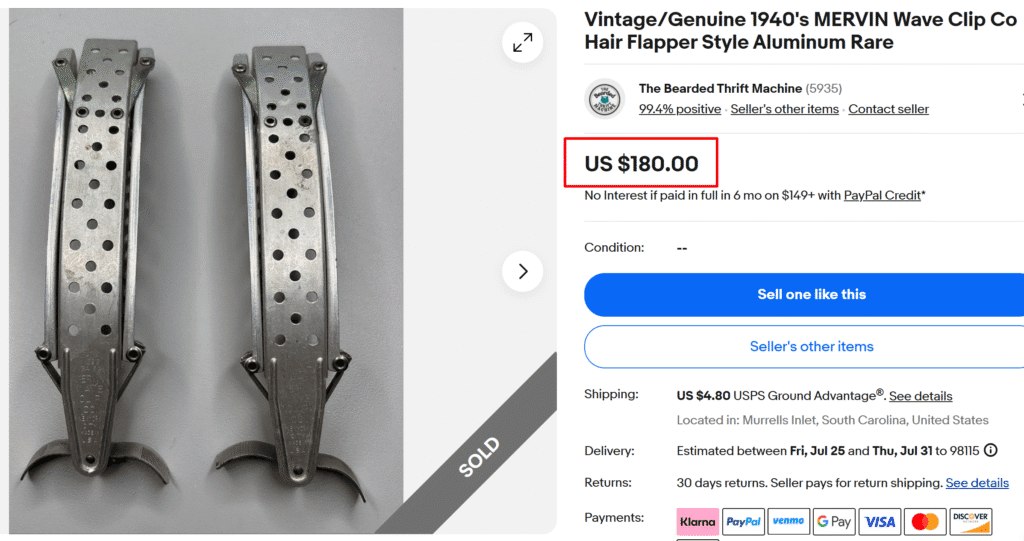
These aluminum Mervin wave clips are one of the most popular hair accessories from the flapper era. You can easily identify these by the distinctive perforated pattern with tiny holes all over that helped create those perfect finger waves.
This pair of two clips sold for $180, because genuine vintage Mervin clips are super rare today. The Mervin Wave Clip Company was based in New York City during the 1930s-40s, and these spring-loaded aluminum clips were one of their most popular accessories.
You may find many old hairclips with similar designs, but real Mervin clips will always have the company etched on the metal in the front. Also, authentic vintage clips will show some natural patina.
8. 90s Louis Vuitton Monogram Brown Hair Clip Barrette
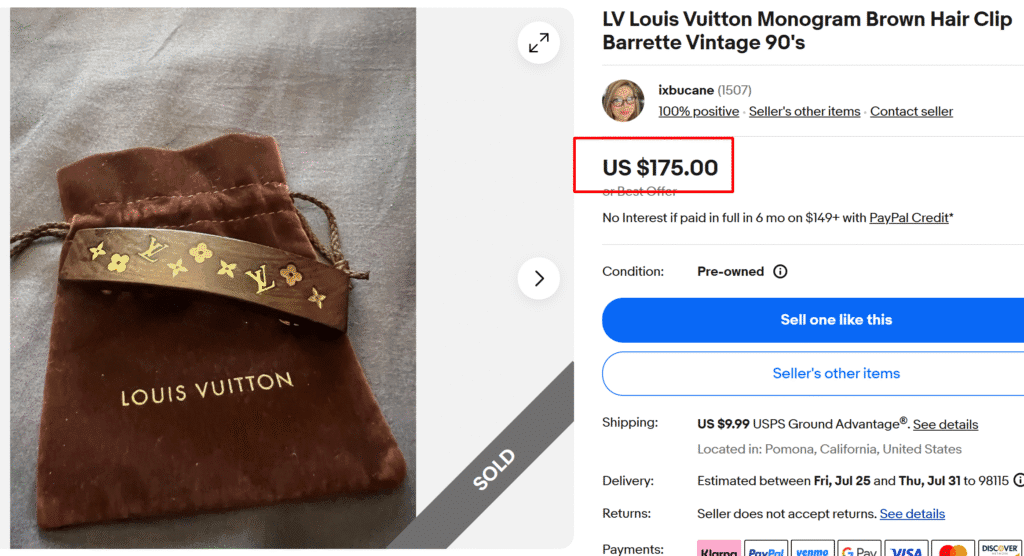
Although not exactly “vintage,” I just couldn’t keep from adding this retro Louis Vuitton wooden hair clip from the 1990s to this list! It displays the iconic “LV” monogram pattern with quatrefoil flowers in the brown and tan colorway that was popular during the 90s.
You’ll also find other markings on the back, like “Made in France” and “GA 0170.” Vintage Louis Vuitton accessories are hot collectibles today, and finding a clip with the iconic monogram pattern AND Louis Vuitton’s original storage pouch is just awesome!
9. Christian Dior Silver Pearl Rhinestone Barrette Clip
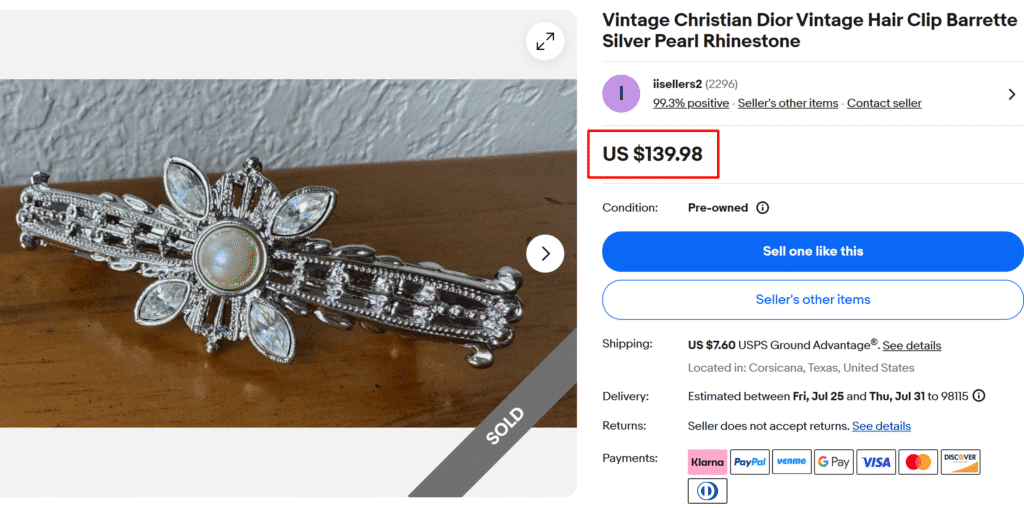
If you find this vintage Christian Dior silver hair clip, think yourself lucky! The central faux pearl surrounded by sparkling rhinestones with a classic silver-tone setting is the key sign to authenticate this vintage Dior barrette.
Looking at those geometric patterns and symmetry all over, plus the materials, you could say this is an Art Deco piece. Such rare Christian Dior clips can be really expensive since they only used the highest quality materials and best craftsmanship!
10. Victorian Engraved Sterling Silver Hair Clips Pair
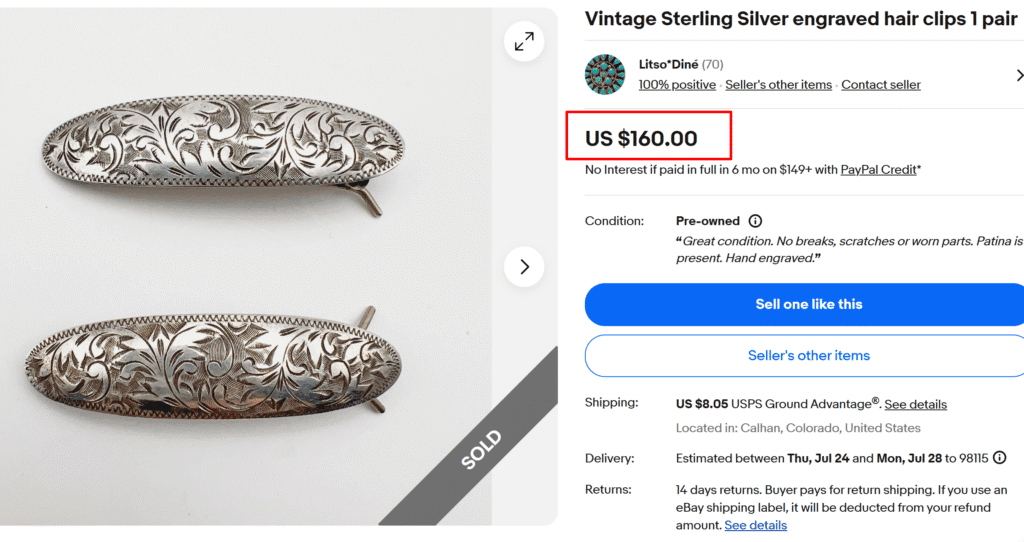
This gorgeous pair of Victorian-style sterling silver clips shows incredible hand-engraved detail with floral and scrollwork motifs on the front. You can tell that these are truly vintage by the traditional oval shape and the spring-loaded clip.
Although there is no company name or logo on these pins, they bear the “Sterling” mark on the back, indicating that they are authentic. Now, this pair might have sold for around $160, but branded pieces can command $500-$1,000 or more.
11. Russian Imperial Silver Enamel Hair Clip
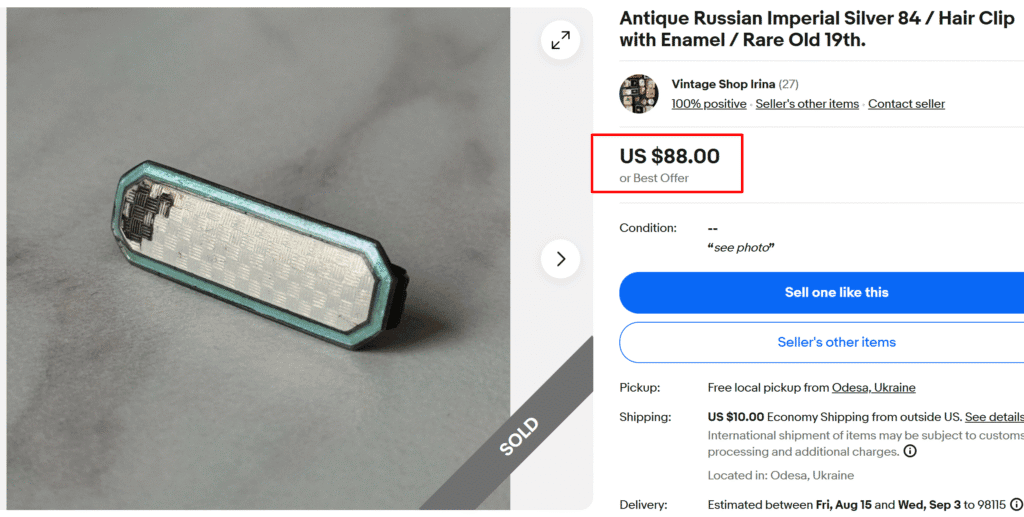
This clip is an example of how rare decorative techniques add rarity and value! It’s a Russian piece featuring the beautiful turquoise-green enamel border around the intricate engine-turned silver pattern in the center.
The decorative technique is called guilloche, and it was quite popular in Russian arts. You’ll also find the “84” marking on the back, indicating the Russian silver grade (875/1000 purity) that was common in premium pieces during the Imperial era. In pristine condition, these enamel hair clips can fetch up to $300 or more!
Note: This article is intended for informational, educational, and entertainment purposes only. Some images are illustrative and may not represent actual brands, products, or related entities. All trademarks, product names, brand logos, packaging, and other intellectual property referenced remain the exclusive property of their respective owners. Any brand mentions or references are provided solely for descriptive and educational context and do not imply any formal or commercial association.

